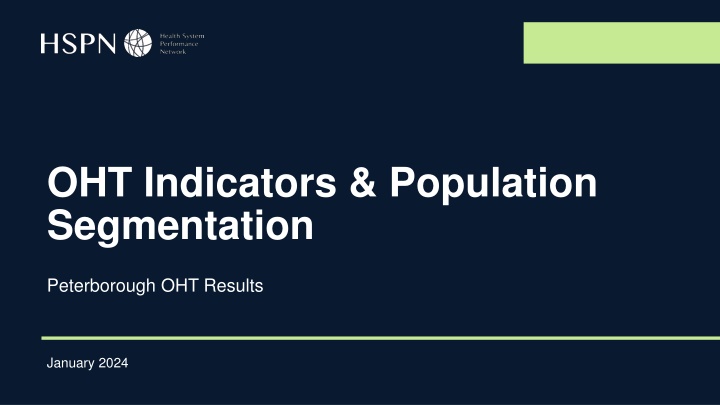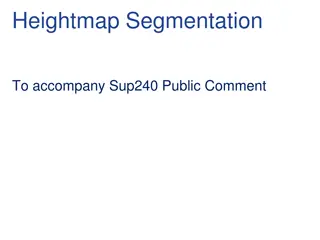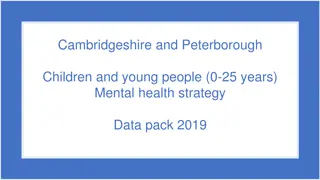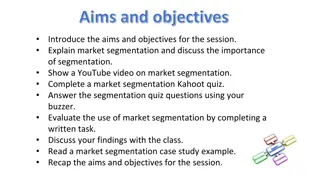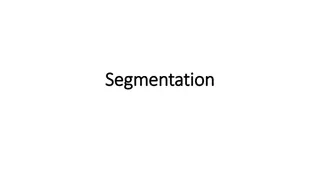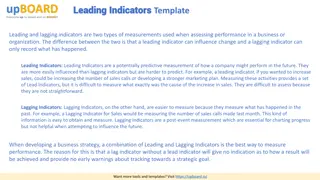OHT Indicators & Population Segmentation: Peterborough OHT Results January 2024
This report presents key indicators and segmentation results for the Peterborough OHT in January 2024. It includes rankings on overall OHT improvement indicators, results for target populations, and data stratified by sub-groupings. The report offers insights on areas for improvement and highlights important indicators for the OHT to focus on.
Uploaded on Feb 22, 2025 | 0 Views
Download Presentation

Please find below an Image/Link to download the presentation.
The content on the website is provided AS IS for your information and personal use only. It may not be sold, licensed, or shared on other websites without obtaining consent from the author.If you encounter any issues during the download, it is possible that the publisher has removed the file from their server.
You are allowed to download the files provided on this website for personal or commercial use, subject to the condition that they are used lawfully. All files are the property of their respective owners.
The content on the website is provided AS IS for your information and personal use only. It may not be sold, licensed, or shared on other websites without obtaining consent from the author.
E N D
Presentation Transcript
OHT Indicators & Population Segmentation Peterborough OHT Results January 2024
How to use this report - 1 This report contains two main sections: oThe first section provides your OHT's ranking on 10 overall OHT improvement indicators and 5 improvement indicators for 3 common target populations (mental health, frail older adults, and end of life/palliative care) oThe second section provides your OHT results for 12 indicators stratified by 4 useful sub-groupings (material deprivation, primary care model, CIHI Pop Health Grouper and BC Health System Matrix). The 12 indicators were identified as being most important to OHTs at this time. 2
How to use this report - 2 1. Have a look at the spider diagram to see which indicators your OHT appears to be close to the centre. Here you are doing well as compared to other OHTs. 2. Use the spider diagrams to see which indicators your OHT appears further to the outside. Many other OHTs are doing better than your OHT on this indicator. Is this an area that is important to your OHT? (You can use the provincial report to see which OHTs are ahead of you). 3. For the indicators that OHTs identified as being most important, you can then look to the second part of the report to find subgroups (by primary care model, material deprivation or health grouping) where you have the greatest opportunity for improvement. These subgroups may point to some conditions that you need to look beyond historical approaches to improvement. You may need additional outreach for low-users or non- rostered patient groups and additional social resources to meet the needs of individuals in high material deprivation (Q4 & Q5). 3
List of Acronyms ACSC: Ambulatory Care Sensitive Condition ADL: Activities of Daily Living ALC: Alternate Level of Care CIHI: Canadian Institute for Health Information ED: Emergency Department MHA: Mental Health and Addictions MDS-HSI: Minimum Data Set Health Status Index 4
Part 1: Part 1: Overall and Population Overall and Population- - specific specific HSPN Improvement HSPN Improvement Indicators Indicators
HSPN OHT Improvement Indicators Older/Frail Adults Palliative & End-of-Life Care Mental Health & Addictions Care Total Population - 2+ fall-related ED visits (among frail) - Days at home (among frail) - Change in ADL long form - Caregiver distress - Change in MDS-HSI - Deaths in hospital - ED visit in the last 30d of life - Palliative - physician home visits in the last 90d of life - Palliative home - care in the last 90d of life - Days at home in the last 6mons of life - Outpatient visits within 7d of MHA hospital discharge - ED as first point of contact for MHA - Frequent (4+) ED visits for MHA - Repeat ED visits within 30d for MHA - Rate of ED visits for deliberate self-harm - Premature Mortality - Cost per Month - Days in Acute Care - ALC Days - ACSC Hospitalizations - 30D Readmission - ED Visit managed elsewhere - 7D Physician Follow up - Continuity of Care - Virtual Visits 6
Spider Diagrams Illustrates your OHTs annual rank amongst all OHTs across 10 total population indicators, 5 MHA indicators, 5 older/frail adult indicators, and 5 end of life indicators (2021/22 to 2022/23). The light grey lines (resembling a spider web) highlight the rank, where closest to the centre indicates the best rank amongst all OHTs. Data points furthest from the centre indicate worst rank in comparison to other OHTs. Each indicator is oriented so that best performance is closest to the centre whether best is represented by high (e.g., physician follow-up) or low (e.g., premature mortality) absolute scores. Spider diagrams measures performance relative to other OHT s each year. Your OHT could have performed better in 2022/23 compared to 2021/22, but if on average the other OHT s also performed better, your point on your spider diagram may be further away from the centre. Spider Diagram Interpretation Try to be SMALL on target is better 7
Introduction to Part 2: Introduction to Part 2: Selecting indicators Selecting indicators and defining stratification / and defining stratification / segmentation approaches segmentation approaches
How did we select indicators for this report? Surveys were distributed to an OHT representative identified by the OHT evaluation lead contact as best suited to answer a survey about the HSPN Improvement Indicators. The survey had 3 multiple choice questions, 3 open text comments and 6 sets of indicators and stratifications to rank. A total of 56 OHTs were invited of whom, 42 responded (75%). Most respondents held positions as (executive) director of the OHT or OHT operations or lead for analysis or population health. OHTs were asked whether we should base a report on a complete set of indicators for one topic or to select a few indicators from different indicator sets. OHTs overwhelming preferred the latter approach and provided rankings of the indicators according to the "priority and usefulness for your OHT". We selected up to 3 indicators from each grouping. For the selected indicators, at least 25% of OHTs selected the indicator as top 2 of 10 from overall indicators or at least 45% of OHTs selected the indicator as top 2 of 5 from population-specific indicators. 13
Top Chosen Indicators: Top Chosen Indicators: Older/Frail Adults Palliative & End-of-Life Care Total Population MHA CQIP 1. ACSC Hospitalization 2. ED Visit managed elsewhere 3. Continuity of Care 1. Frequent (4+ ED visits for MHA) 2. Repeat ED visit for MHA (within 30 days) 3. ED as first point of contact for MHA 1. ALC 2. Cervical Cancer Screening 3. Breast Cancer Screening 1. Repeat fall- related ED visits among those identified as frail 1. Proportion of decedents with home care visits in last 90 days of life 2. Proportion of decedents with 1+ ED visit in last 30 days of life 14
Indicator Definitions Quadruple Aim Indicator Definition Patient Experience (access) & Cost/Efficiency Health Outcomes Number of low-acuity, unscheduled visits to emergency departments for conditions that could be treated in a primary care setting among persons aged 1 to 74 years of age Number of hospital admissions for ambulatory care sensitive conditions (including grand mal status and other epileptic convulsions, chronic obstructive pulmonary disease, asthma, congestive heart failure and pulmonary edema, hypertension, angina, diabetes, and lower respiratory illness) among persons aged 0 to 74 years of age Average proportion of an attributed person s physician visits that was with their most regularly seen doctor Proportion of individuals with an unscheduled emergency department visit that had 4 or more emergency department visits within a 365-day period ED visits best managed elsewhere Hospitalizations for ACSCs Patient Experience Patient Experience & Cost/Efficiency (Health Service Use) Continuity of care Frequent (4+) emergency department visits for help with MHA Repeat emergency visits for MHA (within 30 days) Proportion of unscheduled emergency department visits for care for MH conditions with a second unscheduled emergency department visit for MH or substance abuse within 30 days Patient Experience & Cost/Efficiency Proportion of incident unscheduled emergency department visits for MHA-care where the patient had no prior MHA-related contact (hospitalization, emergency department or physician visit) Patient Experience (Timely Access) & Cost/Efficiency First contact in the emergency department for MHA ALC days PAP Screening Proportion of days in acute inpatient care that were spent in alternate level of care (ALC) Proportion of screen eligible patients (women 23-69 years of age) up to date with Papanicolaou (Pap) tests Proportion of screen-eligible patients (women 52-69 years of age) up to date with a Mammogram Proportion of older adults >65 years of age identified as being frail that had 2 or more unscheduled emergency department visit for fall-related injuries Patient Experience & Cost/Efficiency Patient Experience (access) Patient Experience (access) Health outcome Mammogram Repeat fall-related emergency visits, among those identified as frail Proportion of decedents receiving palliative home care in the last 90 days of life Proportion of decedents with 1 or more emergency department visits in the last 30 days of life The proportion of decedents that had one or more palliative home care services (excluding care management and placement services) in their last 90 days of life Patient Experience (access) & Health Outcome The proportion of decedents that had one or more unplanned emergency department visits in their last 30 days of life Patient Experience (access) & Cost/Efficiency 15
Stratification / Segmentation For the top chosen indicators, we report on the OHT-specific results by four Stratifications or four ways to Segment the population: 1. Neighbourhood Material Deprivation Quintile 2. Primary Care Patient Enrolment Model 3. CIHI Pop Grouper Health Profile Categories (HPCs) 4. BC Health System Matrix Segments 16
Material Deprivation Quintile We use the Material Deprivation Score from the Ontario Marginalization Index to assess equity in OHT indicators across socioeconomic status. Indicators Proportion of the population aged 25 to 64 without a high-school diploma Proportion of families who are lone parent families Proportion of total income from government transfer payments for population aged 15+ Proportion of the population aged 15+ who are unemployed Proportion of the population considered low- income Proportion of households living in dwellings that are in need of major repair Proportion of OHT population according to Neighbourhood Material Deprivation Ontario Health Teams. OHT Attributable Populations: 17
Primary Care Patient Enrolment Models Family Health Teams (FHTs): Capitation-based models with additional interprofessional teams Capitation Based Models (CAP): Family Health Network (FHN), Family Health Organizations (FHO), and Other (mostly this is the Rural and Northern Model) Family Health Groups (FHGs): Partly capitation with after-hours coverage Comprehensive Care Model (CCM): Fee for service with rostered patients Not rostered / Not attached 18
CIHI Population Grouping Methodology From health conditions to health profile categories (HPCs) Identifies dominant health condition driving an individual s health profile Summarizes condition by type and severity 16 health profile categories 164 health profile branches 226 health conditions Diagnoses Splits by presence of significant comorbidities 239 health profile groups 19
BC Health System Matrix Segment BC s Population Segmentation: 14 Health Status Groups Broad Category Population Segment representing highest need for care in year End of Life Frail in Residential Care Frail with High Complex Chronic Conditions In a palliative care or end of life program Living in Licenced residential care High chronic conditions with supports for activities of daily living With supports for activities of daily living, without high chronic conditions High chronic conditions, without supports for activities of daily living Population with cancer diagnosis and treatment Highest health care needs Towards the End of Life Frail living in the community High Complex Chronic Conditions, not Frail Cancer Living with Illness and Chronic Conditions Severe Mental Illness and Substance Use Medium Complex Chronic Conditions Low Complex Chronic Conditions Children and Youth Major Conditions Adults Major Conditions Hospitalized for MH or SU in 5 year period Specific Medium Chronic Conditions or comorbidities Specific Low Chronic Conditions Significant time-limited health needs, without chronic conditions. Includes Newborns with health conditions Healthy, low users, with minor episodic health care needs Getting Better Lowest health care needs Healthy Staying Healthy Maternity and Healthy Newborns Non-users Maternity, Obstetrics and newborns People who used no health care in year Health System Matrix 6.1, BC Ministry of Health 2015 9 20 20
Time Periods for Assigning Stratifications Assignment to subgroups is based on information on April 1stof the indicator year: OHIP address for the individual is used to assign to Material Deprivation Category using the dissemination area and 2021 Census Primary care models based on enrolment as at April 1 CIHI Pop Grouper is based on utilization in the prior fiscal year BCHSM classification is based on utilization in prior fiscal year along with conditions diagnosed over different/varying periods of time. See full technical report for more details : [https://hspn.ca/wp-content/uploads/2022/03/HSPN_SEGMENTATION_TECH_APPENDIX_March_2022.pdf ] 21
Part 2: Part 2: 12 Select Indicators 12 Select Indicators with 4 Stratifications with 4 Stratifications
Rate of ED Visits best managed elsewhere DEFINITION Quadruple Aim Rate of low-acuity, unscheduled visits to emergency departments for conditions that could be treated in a primary care setting among persons aged 1 to 74 years of age Patient Experience (access) In this graph the horizontal scale represents the rate of ED visits per 1000 patients. This is calculated as the number of patients admitted to ED with a condition that could be managed elsewhere divided by the population in the OHT attributed population who are aged 1 to 74. Sample Interpretation: In the most deprived communities (Q5), 14 patients per 1000 person years visit the ED for reasons best managed elsewhere. Lower values are preferred on average and indicate better access to care for low acuity conditions in the community. 23
2022/23 Rate of ED Visits best managed elsewhere by Material Deprivation Quintile Horizontal axis presents rate of ED visits per 1000 person years that could be treated in alternative primary care setting. OHT and Ontario average indicated in figure footnote. Blank rows represent segments with no events, small counts < 5, or with < 30 patients in denominator. 24
2022/23 Rate of ED Visits best managed elsewhere by Primary Care Model Horizontal axis presents rate of ED visits per 1000 person years that could be treated in alternative primary care setting. OHT and Ontario average indicated in figure footnote. Blank rows represent segments with no events, small counts < 5, or with < 30 patients in denominator. 25
2022/23 Rate of ED Visits best managed elsewhere by CIHI Population Grouping Methodology Horizontal axis presents rate of ED visits per 1000 person years that could be treated in alternative primary care setting. OHT and Ontario average indicated in figure footnote. Blank rows represent segments with no events, small counts < 5, or with < 30 patients in denominator. 26
2022/23 Rate of ED Visits best managed elsewhere by BC Matrix Segment Horizontal axis presents rate of ED visits per 1000 person years that could be treated in alternative primary care setting. OHT and Ontario average indicated in figure footnote. Blank rows represent segments with no events, small counts < 5, or with < 30 patients in denominator. 27
Hospitalizations for ACSCs DEFINITION Quadruple Aim Health Outcomes Number of hospital admissions for ambulatory care sensitive conditions (including chronic obstructive pulmonary disease, asthma, congestive heart failure and pulmonary edema, hypertension, angina, diabetes, epilepsy and lower respiratory illness) among persons aged 0 to 74 years of age divided by the OHT population aged 0 - 74. In this graph the horizontal scale represents the rate of ED visits per 1000 patients. This is calculated as the number of patients admitted to ED with a condition that could be managed elsewhere divided by the population in the OHT attributed population who are aged 0 to 74. Sample Interpretation: In the most deprived communities (Q5), 805 patients per 100,000 person years are hospitalized for ambulatory care conditions. Lower values are preferred on average and indicate a better functioning care in the community/ambulatory settings. 28
2022/23 Rate of hospitalization for ambulatory care sensitive conditions (ACSC) per 100k by Material Deprivation Quintile Horizontal axis presents rate of hospitalization for ambulatory care sensitive condition per 100k: OHT and Ontario average indicated in figure footnote. Blank rows represent segments with no events, small counts < 5, or with < 30 patients in denominator. 29
2022/23 Rate of hospitalization for ambulatory care sensitive conditions (ACSC) per 100k by Primary Care Model Horizontal axis presents rate of hospitalization for ambulatory care sensitive condition per 100k: OHT and Ontario average indicated in figure footnote. Blank rows represent segments with no events, small counts < 5, or with < 30 patients in denominator. 30
2022/23 Rate of hospitalization for ambulatory care sensitive conditions (ACSC) per 100k CIHI Population Grouping Methodology Horizontal axis presents rate of hospitalization for ambulatory care sensitive condition per 100k: OHT and Ontario average indicated in figure footnote. Blank rows represent segments with no events, small counts < 5, or with < 30 patients in denominator. 31
2022/23 Rate of hospitalization for ambulatory care sensitive conditions (ACSC) per 100k by BC Matrix Segment Horizontal axis presents rate of hospitalization for ambulatory care sensitive condition per 100k: OHT and Ontario average indicated in figure footnote. Blank rows represent segments with no events, small counts < 5, or with < 30 patients in denominator. 32
Mean (Average) Physician Continuity of Care DEFINITION Quadruple Aim Patient Experience Average proportion of an attributed person s physician visits that was with their most regularly seen doctor In this graph the horizontal scale represents the average Continuity of Care (CoC) amongst all patients attributed to this OHT where CoC is measured as the proportion of all physician visits that are with the doctor that they see the most often. Sample Interpretation: In the most deprived communities 61% of patients' visits to the doctor were to the same doctor. Higher numbers indicate greater continuity of care and are an indicator of relationship continuity. Higher values are preferred on average. Specialist direct referrals to other specialists without involvement of a persons' most regularly seen doctor are one of the main ways continuity is decreased. 33
2022/23 Mean continuity of care (measured by the Usual Provider of Care Index) by Material Deprivation Quintile Horizontal axis presents the mean continuity of care (measured by the Usual Provider of Care Index): OHT and Ontario average indicated in figure footnote. Blank rows represent segments with no events, small counts < 5, or with < 30 patients in denominator. 34
2022/23 Mean continuity of care (measured by the Usual Provider of Care Index) by Primary Care Model Horizontal axis presents the mean continuity of care (measured by the Usual Provider of Care Index): OHT and Ontario average indicated in figure footnote. Blank rows represent segments with no events, small counts < 5, or with < 30 patients in denominator. 35
2022/23 Mean continuity of care (measured by the Usual Provider of Care Index) by CIHI Population Grouping Methodology Horizontal axis presents the mean continuity of care (measured by the Usual Provider of Care Index): OHT and Ontario average indicated in figure footnote. Blank rows represent segments with no events, small counts < 5, or with < 30 patients in denominator. 36
2022/23 Mean continuity of care (measured by the Usual Provider of Care Index) by BC Matrix Segment Horizontal axis presents the mean continuity of care (measured by the Usual Provider of Care Index): OHT and Ontario average indicated in figure footnote. Blank rows represent segments with no events, small counts < 5, or with < 30 patients in denominator. 37
Alternate Level of Care (ALC) days DEFINITION Quadruple Aim Proportion of days in acute inpatient care that were spent in alternate level of care (ALC) Patient Experience & Efficiency In this graph the horizontal axis measures the total number of hospital inpatient days amongst all patients in your OHT attributable population and the colours represent how many of those days are acute versus alternate level of care. In this graph the size of the bright green matters because it shows where the largest number of ALC days are incurred. Sample Interpretation: The proportion of inpatient days designated as ALC days in the most deprived communities (Q5) is 22.5%. Lower values are preferred on average and indicate good discharge processes and partnerships between hospital and community settings to accelerate transfer of care to community. 38
2022/23 ALC Days (percent of acute days) in acute hospitals by Material Deprivation Quintile Horizontal axis presents total inpatient days: Bright green indicates ALC days; Dark blue represents non- ALC inpatient days; Percentage to the right is the proportion of inpatient days designated as ALC. OHT and Ontario average indicated in figure footnote. Blank rows represent segments with no events, small counts < 5, or with < 30 patients in denominator. 39
2022/23 ALC Days (percent of acute days) in acute hospitals by Primary Care Model Horizontal axis presents total inpatient days: Bright green indicates ALC days; Dark blue represents non- ALC inpatient days; Percentage to the right is the proportion of inpatient days designated as ALC. OHT and Ontario average indicated in figure footnote. Blank rows represent segments with no events, small counts < 5, or with < 30 patients in denominator. 40
2022/23 ALC Days (percent of acute days) in acute hospitals by CIHI Population Grouping Methodology Horizontal axis presents total inpatient days: Bright green indicates ALC days; Dark blue represents non- ALC inpatient days; Percentage to the right is the proportion of inpatient days designated as ALC. OHT and Ontario average indicated in figure footnote. Blank rows represent segments with no events, small counts < 5, or with < 30 patients in denominator. 41
2022/23 ALC Days (percent of acute days) in acute hospitals by BC Matrix Segment Horizontal axis presents total inpatient days: Bright green indicates ALC days; Dark blue represents non- ALC inpatient days; Percentage to the right is the proportion of inpatient days designated as ALC. OHT and Ontario average indicated in figure footnote. Blank rows represent segments with no events, small counts < 5, or with < 30 patients in denominator. 42
Cervical Cancer Screening with Papanicolaou Test DEFINITION Quadruple Aim Proportion of screen eligible patients (women 23-69 years of age) up to date with Papanicolaou (Pap) tests ) Patient Experience (access) In this graph, the horizontal axis measures the total number of individuals who are eligible to have cervical cancer screening in your OHT attributable population and the colours represent how many of these individuals are, and are not, up to date with their Pap test. In this graph the size of the bright green matters because it shows the population groups where the largest number of tests have not been completed. Sample Interpretation: 54.5% of patients in the most deprived communities (Q5) were up to date with their cervical cancer screening. Higher values are preferred and support early detection and better survival amongst women diagnosed with cervical cancer. 43
Percentage of screen-eligible patients (women 23-69 yrs of age) up to date with Papanicolaou (Pap) tests on March 31, 2023 by Material Deprivation Quintile Horizontal axis shows the number of women 23-69 years Bright green indicates number of women not screened; Dark blue represents number of women screened; Percentage to the right is the proportion of each segment screened. OHT and Ontario average indicated in figure footnote. Blank rows represent segments with no events, small counts < 5, or with < 30 patients in denominator. 44
Percentage of screen-eligible patients (women 23-69 yrs of age) up to date with Papanicolaou (Pap) tests on March 31, 2023 by Primary Care Model Horizontal axis shows the number of women 23-69 years Bright green indicates number of women not screened; Dark blue represents number of women screened; Percentage to the right is the proportion of each segment screened. OHT and Ontario average indicated in figure footnote. Blank rows represent segments with no events, small counts < 5, or with < 30 patients in denominator. 45
Percentage of screen-eligible patients (women 23-69 yrs of age) up to date with Papanicolaou (Pap) tests on March 31, 2023 by CIHI Population Grouping Methodology Horizontal axis shows the number of women 23-69 years Bright green indicates number of women not screened; Dark blue represents number of women screened; Percentage to the right is the proportion of each segment screened. OHT and Ontario average indicated in figure footnote. Blank rows represent segments with no events, small counts < 5, or with < 30 patients in denominator. 46
Percentage of screen-eligible patients (women 23-69 yrs of age) up to date with Papanicolaou (Pap) tests on March 31, 2023 by BC Matrix Segment Horizontal axis shows the number of women 23-69 years Bright green indicates number of women not screened; Dark blue represents number of women screened; Percentage to the right is the proportion of each segment screened. OHT and Ontario average indicated in figure footnote. Blank rows represent segments with no events, small counts < 5, or with < 30 patients in denominator. 47
Breast Cancer Screening with Mammogram DEFINITION Quadruple Aim Proportion of screen-eligible patients (women 52-69 years of age) up to date with a Mammogram Patient Experience (access) In this graph, the horizontal axis measures the total number of individuals who are eligible to have breast cancer screening in your OHT attributable population and the colours represent how many of these individuals are, and are not, up to date with their Mammogram screening. In this graph the size of the bright green matters because it shows the population groups where the largest number of tests have not been completed. Sample Interpretation: 57.7% of patients in the most deprived communities (Q5) were up to date with their Mammogram screening. Higher values are preferred and support early detection and better survival amongst women diagnosed with breast cancer. 48
Percentage of screen-eligible patients (women 52-69 years of age) up to date with a Mammogram on March 31, 2023 by Material Deprivation Quintile Horizontal axis shows the number of women 52-69 years: Bright green indicates number of women not screened; Dark blue represents number of women screened; Percentage to the right is the proportion of each segment screened. OHT and Ontario average indicated in figure footnote. Blank rows represent segments with no events, small counts < 5, or with < 30 patients in denominator. 49
Percentage of screen-eligible patients (women 52-69 years of age) up to date with a Mammogram on March 31, 2023 by Primary Care Model Horizontal axis shows the number of women 52-69 years: Bright green indicates number of women not screened; Dark blue represents number of women screened; Percentage to the right is the proportion of each segment screened. OHT and Ontario average indicated in figure footnote. Blank rows represent segments with no events, small counts < 5, or with < 30 patients in denominator. 50
